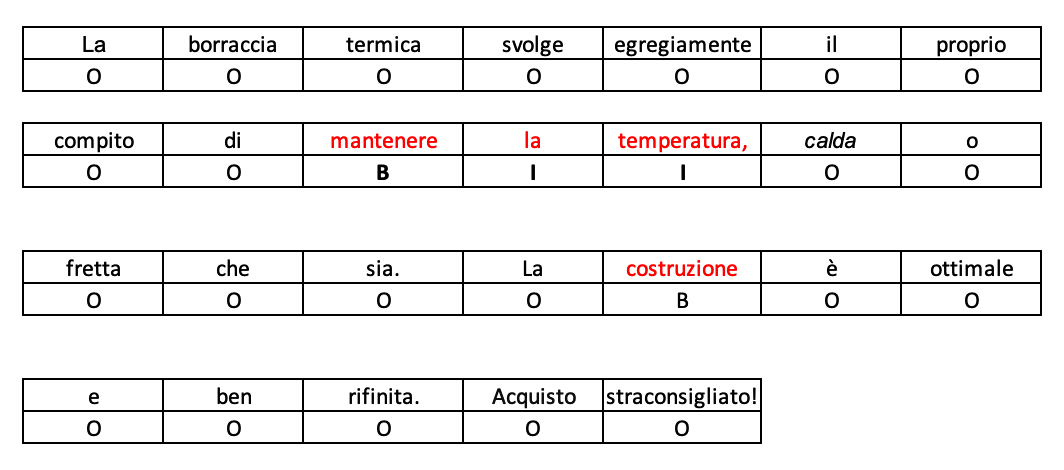Tasks
TASK 1 - ATE: Aspect Term Extraction
Aspect Term Extraction (ATE) is the task of identifying an "aspect" in a text without knowing a priori the list that contains it. According to the literature definition, a term/phrase is considered as an aspect when it co-occurs with “opinion words” that indicate a sentiment polarity on it.

For example, let us consider the sentence describing a review of a metallic bottle:
"La borraccia termica svolge egregiamente il proprio compito di mantenere la temperatura, calda o fretta che sia. La costruzione è ottimale e ben rifinita. Acquisto straconsigliato!"
In the Aspect Term Extraction (ATE) task one or more "aspect terms" evoked in a sentence are identified, e.g. the mantenere la temperatura (keep the temperature), costruzione (construction) in sentence. Given a sequence X = {x,...,xT} of T words, the ATE task can be formulated as a token/word level sequence labeling problem to predict an aspect label sequence Y = {y1,...,yT}, where each yi comes from a finite label set Y={B,I,O} which describes the possible aspect labels (begin, inside, outside). An example of ATE annotation is provided in Fig. 1
We define an aspect term as:
- An attribute (characteristic, property, feature, quality) of the object itself
- A tangible or abstract part of the object, for which an opinion can be inferred from the review
- The activities that the object is able (or not able) to perform
- The object's ability to be suitable for certain categories of people
An aspect term does not identify opinions regarding elements external to the object, such as:
- the shipment (it is not an intrinsic property of the object),
- the company that produced them, the series to which the product belongs or other products with which the object is compared,
- the elements about the buying action
- the elements about the customer care
More details and examples are available here.
TASK 2 - ABSA: Aspect-based Sentiment Analysis
Aspect-based Sentiment Analysis (ABSA) is an evolution of Sentiment Analysis that aims at capturing the aspect-level opinions expressed in natural language texts.

In the Aspect-based Sentiment Analysis (ABSA) task, the polarity of each expressed aspect is recognized, e.g. a positive category polarity is expressed concerning the mantenere la temperatura aspect. The results of the annotation of the previously mentioned example is available in Fig. 2. Note that the two labels are not mutually exclusive: in addition to the annotation of positive (POS:true,NEG:false) aspect and negative (POS:false,NEG:true) aspect, there can be aspects with mixed polarity(POS:true, NEG:true), or neutral polarity (POS:false, NEG:false). Positive and negative labels are those most popular but do not exclude the possible neutral and mixed polarity values.
TASK 3 - SA: Sentiment Analysis
Sentiment Analysis (or Opinion Mining) is the task of identifying what the user thinks about a particular piece of text. In particular, it often takes the form of an annotation task with the purpose of annotating a portion of text with a positive, negative, or neutral label.

In our Sentiment Analysis (SA) task, the polarity of the review is provided. In particular we decided to use the score left by the user at the item as value of polarity. It is defined as an integer number into the range 1:5. An example is provided in FIg. 3.